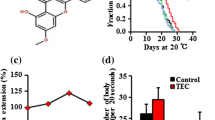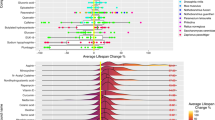Abstract
Compounds with lifespan extension activity are rare, although increasing research efforts have been invested in this field to find ways to extend healthy lifespan. By applying a yeast-based high-throughput assay to identify the chronological lifespan extension activity of mulberry extracts rapidly, we demonstrated that a group of prenylated flavones, particularly morusin and mulberrin, could extend the chronological lifespan of budding yeast via a nutrient-dependent regime by at least partially targeting SCH9. Their antiaging activity could be extended to C. elegans by promoting its longevity, dependent on the full functions of genes akt-1 or akt-2. Moreover, additional benefits were observed from morusin- and mulberrin-treated worms, including increased reproduction without the influence of worm health (pumping rate, pumping decline, and reproduction span). In the human HeLa cell model, morusin and mulberrin inhibited the phosphorylation of p70S6K1, promoted autophagy, and slowed cell senescence. The molecular docking study showed that mulberrin and morusin bind to the same pocket of p70S6K1. Collectively, our findings open up a potential class of prenylated flavones performing their antiaging activity via nutrient-sensing pathways.






Similar content being viewed by others
Data availability
The raw data tables are available upon request from the corresponding author.
References
Partridge L, Deelen J, Slagboom PE. Facing up to the global challenges of ageing. Nature. 2018;561(7721):45–56.
Lee MB, et al., Antiaging diets: separating fact from fiction. Science, 2021. 374(6570): p. eabe7365.
Fontana L, Partridge L. Promoting health and longevity through diet: from model organisms to humans. Cell. 2015;161(1):106–18.
López-Lluch G, Navas P. Calorie restriction as an intervention in ageing. J Physiol. 2016;594(8):2043–60.
Dorling JL, et al. Effects of caloric restriction on human physiological, psychological, and behavioral outcomes: highlights from CALERIE phase 2. Nutr Rev. 2021;79(1):98–113.
Madeo F, et al. Caloric restriction mimetics: towards a molecular definition. Nat Rev Drug Discovery. 2014;13(10):727–40.
Dilova I, Easlon E, Lin S-J. Calorie restriction and the nutrient sensing signaling pathways. Cell Mol Life Sci. 2007;64(6):752–67.
Madeo F, et al. Caloric restriction mimetics against age-associated disease: targets, mechanisms, and therapeutic potential. Cell Metab. 2019;29(3):592–610.
Lopez-Otin C, et al. The hallmarks of aging. Cell. 2013;153(6):1194–217.
Oz N, et al., Evidence that conserved essential genes are enriched for pro-longevity factors. bioRxiv, 2022.
Partridge L, Fuentealba M, Kennedy BK. The quest to slow ageing through drug discovery. Nat Rev Drug Discovery. 2020;19(8):513–32.
Wilkinson JE, et al. Rapamycin slows aging in mice. Aging Cell. 2012;11(4):675–82.
Kim J, Guan KL. mTOR as a central hub of nutrient signalling and cell growth. Nat Cell Biol. 2019;21(1):63–71.
Kaeberlein M, Kennedy BK. Hot topics in aging research: protein translation and TOR signaling, 2010. Aging Cell. 2011;10(2):185–90.
Johnson SC, Rabinovitch PS, Kaeberlein M. mTOR is a key modulator of ageing and age-related disease. Nature. 2013;493(7432):338–45.
Murakami C, Kaeberlein M. Quantifying yeast chronological life span by outgrowth of aged cells. J Vis Exp, 2009(27).
Wu Z, et al. A high throughput screening assay for determination of chronological lifespan of yeast. Exp Gerontol. 2011;46(11):915–22.
Wu Z, et al. Tanshinones extend chronological lifespan in budding yeast Saccharomyces cerevisiae. Appl Microbiol Biotechnol. 2014;98(20):8617–28.
Deng ZP. et al., Quantification of morusin using LC-MS in rat plasma: application to a pharmacokinetic study. Biomedical Chromatography, 2017. 31(12).
Wu ZY, Liu SQ, Huang DJ. Dietary restriction depends on nutrient composition to extend chronological lifespan in budding yeast Saccharomyces cerevisiae. Plos One, 2013. 8(5).
Wu Z.Y., et al., Independent and additive effects of glutamic acid and methionine on yeast longevity. Plos One, 2013. 8(11).
Smith J, Daniel L, et al. Calorie restriction extends the chronological lifespan of Saccharomyces cerevisiae independently of the sirtuins. Aging Cell. 2007;6(5):649–62.
Longo VD, et al. Replicative and chronological aging in Saccharomyces cerevisiae. Cell Metab. 2012;16(1):18–31.
Urban J, et al. Sch9 is a major target of TORC1 in Saccharomyces cerevisiae. Mol Cell. 2007;26(5):663–74.
Blackwell TK, et al., TOR signaling in Caenorhabditis elegans development, metabolism, and aging. 2019. 213(2): p. 329–360.
Houthoofd, K., et al., Dietary restriction in the nematode Caenorhabditis elegans, in Mechanisms of dietary restriction in aging and disease. 2007, Karger Publishers. p. 98–114.
Fabrizio P, et al. Regulation of longevity and stress resistance by Sch9 in yeast. Science. 2001;292(5515):288–90.
Maier AB., Westendorp RGJ, Van Heemst D. Beta-galactosidase activity as a biomarker of replicative senescence during the course of human fibroblast cultures. Biogerontology: Mechanisms and Interventions, 2007. 1100: p. 323–332.
Jastrzebski K, et al. Coordinate regulation of ribosome biogenesis and function by the ribosomal protein S6 kinase, a key mediator of mTOR function. Growth Factors. 2007;25(4):209–26.
Rubinsztein DC, Marino G, Kroemer G. Autophagy and aging. Cell. 2011;146(5):682–95.
Velikkakath AKG, et al. Mammalian Atg2 proteins are essential for autophagosome formation and important for regulation of size and distribution of lipid droplets. Mol Biol Cell. 2012;23(5):896–909.
Lee MB, et al. Pterocarpus marsupium extract extends replicative lifespan in budding yeast. Geroscience. 2021;43(5):2595–609.
Lashmanova E., et al., The Evaluation of geroprotective effects of selected flavonoids in Drosophila melanogaster and Caenorhabditis elegans. Frontiers in Pharmacology, 2017. 8.
Guerrero-Rubio M.A., et al., Flavonoids’ effects on Caenorhabditis elegans’ longevity, fat accumulation, stress resistance and gene modulation involve mTOR, SKN-1 and DAF-16. Antioxidants, 2021. 10(3).
Batiha G.E., et al., The pharmacological activity, biochemical properties, and pharmacokinetics of the major natural polyphenolic flavonoid: quercetin. Foods, 2020. 9(3).
Carmona-Gutierrez D., et al., The flavonoid 4,4 '-dimethoxychalcone promotes autophagy-dependent longevity across species. Nature Communications, 2019. 10.
Pallauf K, Duckstein N, Rimbach G. A literature review of flavonoids and lifespan in model organisms. Proceed Nutri Soc. 2017;76(2):145–62.
Keith S.A., et al., The C. elegans healthspan and stress-resistance assay toolkit. Methods, 2014. 68(3): p. 476–486.
Funding
The research is sponsored by an in-house grant of the NUS (Suzhou) Research Institute (NUSRI) under the Peak of Excellent for Health and a Tier 1 grant (R-160–000-B04-114) from the Singapore Ministry of Health. ZW is sponsored by the Shanghai Pujiang Program (20PJ1405400) and the National Natural Science Foundation of China (No. 82171550). Some C. elegans strains were provided by CGC, which is funded by the NIH Office of Research Infrastructure Programs (P40 OD010440).
Author information
Authors and Affiliations
Contributions
Qimin Chen, with the assistance of Shuoyu Chen and Amelia Gunawan, designed and conducted high-throughput screening of the mulberry samples; isolated the active compounds, morusin, and cudraflavone C, from mulberry twigs; as well conducted experiments on the structure and activity relationship on yeast model. Pingkang Xu (PX) designed and conducted the experiments on structural and activity relationships (assisted by Xiaoman Chen and Weiqi Li) and conducted the experiment related to C. elegans (assisted by Yuyan Yang and Weiqi Li) and HeLa cells (assisted by Yao Qi and Xiaoman Chen). Xin Yang performed the crystal growth and structural analysis of morusinol and molecular docking study. Li Xu collected the authentic mulberry samples for screening, and Ziyun Wu (ZW) conducted experiments on HeLa cells and provided general advice on the project. Han-Ming Shen (HMS) advised on autophagy and HeLa cell aging experiments. Brian Kennedy (BK) provided yeast strains and recommended investigating the action mechanisms. Huimin Zhang (HZ) guided the C. elegans study conducted in his lab. Dejian Huang (DH) conceived the project. The manuscript was drafted by PX, QC, ZW, and DH. The subsequent refinement of the manuscript was contributed by ZW, BK, HMS, and HZ.
Corresponding authors
Ethics declarations
Competing interests
The authors declare no competing interests.
Additional information
Publisher's note
Springer Nature remains neutral with regard to jurisdictional claims in published maps and institutional affiliations.
Supplementary information
Below is the link to the electronic supplementary material.
About this article
Cite this article
Xu, P., Chen, Q., Chen, X. et al. Morusin and mulberrin extend the lifespans of yeast and C. elegans via suppressing nutrient-sensing pathways. GeroScience 45, 949–964 (2023). https://doi.org/10.1007/s11357-022-00693-2
Received:
Accepted:
Published:
Issue Date:
DOI: https://doi.org/10.1007/s11357-022-00693-2




